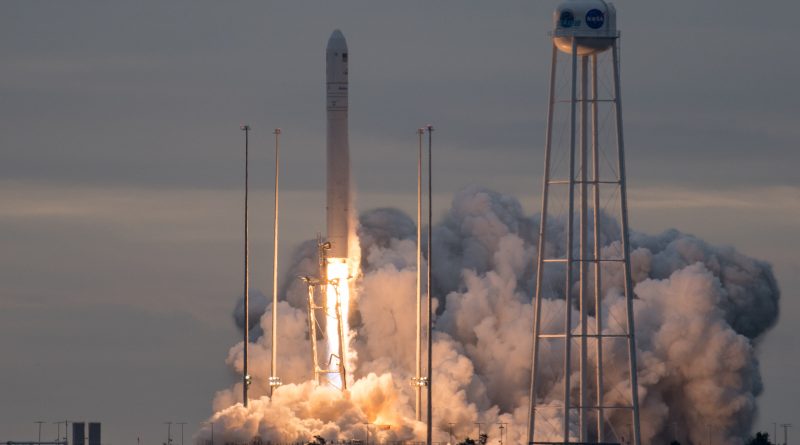Cygnus “S.S. Gene Cernan” En-Route to Space Station after Sunday Morning Commute to Orbit
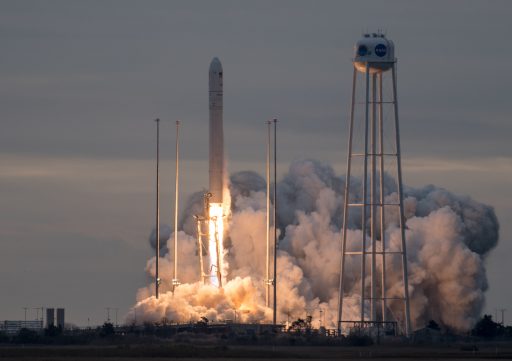
An Antares rocket thundered off from Virginia’s Eastern Shore Sunday morning after a year-long break, carrying into orbit the eighth operational Cygnus cargo spacecraft headed to the International Space Station with over three metric tons of science gear, maintenance hardware and crew supplies. Antares lifted off from the Wallops Flight Facility at 12:19 UTC and operated as advertised to lift the 6,200-Kilogram cargo spacecraft into Low Earth Orbit for arrival at its high-altitude destination on Tuesday.
The Cygnus OA-8 spacecraft, christened the S.S. Gene Cernan after the late Gemini and Apollo Astronaut and the last human to set foot on the Moon, is loaded with 3,338 Kilograms of cargo for the International Space Station. It is the fifth U.S. resupply mission flying to ISS in 2017, coming after three successful Dragon missions and the Cygnus OA-7 flight that used an Atlas V rocket.
Sunday’s launch was only the second flight of the upgraded Antares rocket that had debuted successfully over a year ago in October 2016 after a two-year stand-down following the dramatic 2014 launch failure of the original Antares rocket.
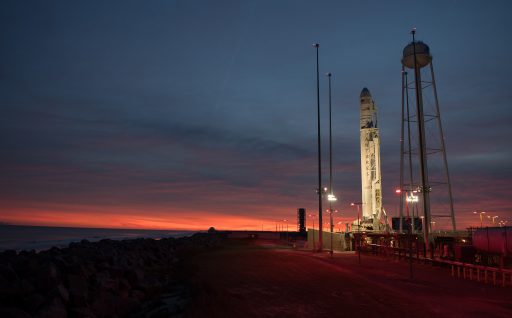
While Antares was sent back to the drawing board to be fitted with new engines, two Cygnus missions flew on Atlas V rockets to keep up Orbital ATK’s obligations to NASA under their Commercial Resupply Services contract – also making up for lost cargo upmass on the Orb-3 mission as Atlas V allowed both Cygnus vehicles to be packed to capacity.
The decision to shift the OA-7 mission earlier this year to Atlas V was made by Orbital ATK and NASA to take advantage of the vehicle’s schedule certainty and to maximize cargo upmass before the U.S. Segment aboard ISS stepped up to four crew members as a result of Russia cutting its ISS crew to two.
It also took some pressure off Orbital ATK’s Antares team that had worked long hours on the Return To Flight effort of the re-engined Antares, now featuring a pair of RD-181 engines instead of the AJ26 engines that represented converted Soviet engines built in the 1970s and proved troublesome in the Orb-3 failure and multiple testing incidents.
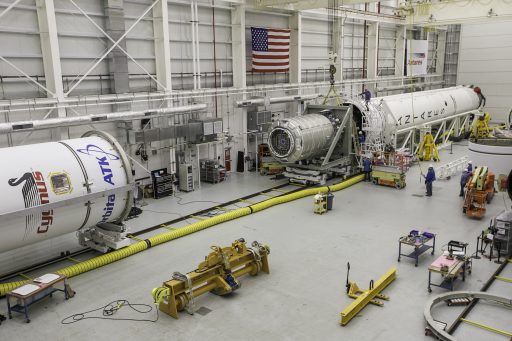
Orbital ATK informed NASA in early 2017 that the company would be able to support the OA-8 mission in the summer, potentially as early as July. OA-8 received an initial launch date in mid-September, but NASA requested the launch to be pushed two months for additional cargo to be readied. After three science-laden Dragon missions earlier this year, the Cygnus OA-8 mission is more on the supplies side and less focused on science with a total of 3,229 Kilograms of cargo packed into the pressurized section of the spacecraft.
Cargo aboard the S.S. Gene Cernan is comprised of 1,240 Kilograms of crew supplies including food and clothing, 851 Kilograms of vehicle hardware to keep ISS operating at full capacity, 740kg of science gear including several new experiments and materials for ongoing studies, and 166kg of spacewalk equipment and computer resources. 109kg of cargo are mounted externally as Cygnus OA-8 carries a full complement of 14 CubeSats in its own NanoRacks CubeSat Deployers for release into an orbit 100 Kilometers above ISS after Cygnus departs ISS.
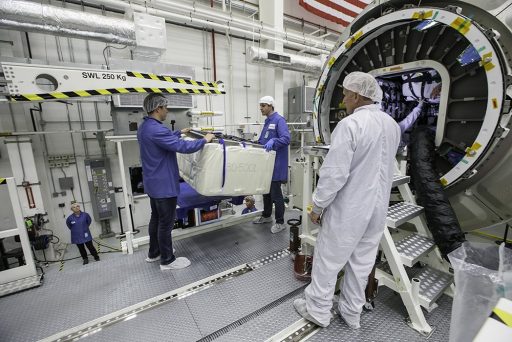
The OA-8 mission is flying with two powered Polar freezers containing cold-stowage samples for various experiments and the Space Tango TangoLab module, containing several CubeSat-sized experiments for education and research, will be used to demonstrate that Cygnus could be used as an extension of the ISS laboratory modules by hosting experiments like the modular TangoLab. The spacecraft is booked for a three-week stay at ISS to be fully unloaded and depart the complex before the next Dragon spacecraft arrives, currently working toward launch on December 4.
After flying on three United Launch Alliance Atlas V rockets, Orbital ATK expects to fly out its remaining manifest of four CRS-1 missions on Antares, including the OA-8 mission. The CRS-1 contracts have been extended by NASA, giving Orbital ATK and SpaceX additional missions through 2019 to bridge a gap until the second round of CRS contracts can go into effect with three cargo vehicle operators.
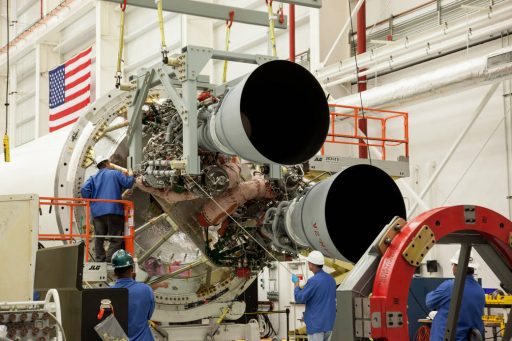
The upgraded Antares 200-series, in addition to a higher reliability expectation, also offers greater performance than its 100-series predecessors, enabled by the more powerful RD-181 engines manufactured by NPO Energomash in Russia as a single-chamber version of the two-chamber RD-180 used on Atlas V and the four-chamber RD-171 on the Zenit rocket. During the first Antares 230 mission in 2016, Orbital ATK flew the vehicle with very conservative margins – shutting the first stage down when reaching a target velocity from which the Castor 30XL second stage could boost the vehicle into orbit.
However, post-flight analysis showed that the first stage had considerable propellant leftovers when hitting its target speed, boding well for further pushing Antares’ performance by burning the first stage longer. Even with the conservative first stage shutdown, Antares achieved a slight overperformance on the OA-5 mission, translating to an apogee altitude around 50 Kilometers above the expected high point of the injection orbit.
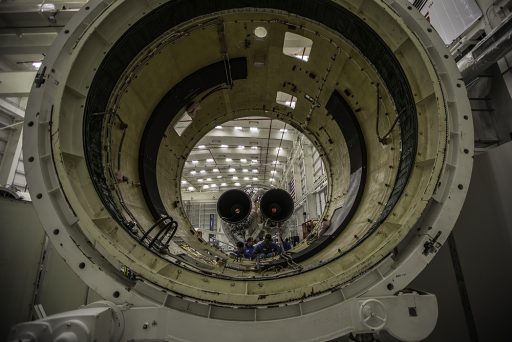
Antares was programmed to fire its first stage for an additional five seconds on Sunday, allowing an additional cargo upmass of 150 Kilograms. Further performance refinement and some minor upgrades will add another 150-200 Kilograms which would allow Cygnus to be loaded to its maximum capacity of 3,500 Kilograms on future missions.
Standing 42.5 meters tall and measuring 3.9 meters in diameter, Antares has a launch mass of 298 metric tons and represents a combination of components build in the Ukraine, Russia and U.S. – combining the expertise of Orbital ATK in the field of solid rockets for the second stage, Russia’s high-performing oxygen-rich engine technology, and tankage from the Zenit rocket developed and built in the Ukraine.
>>Antares 230 Launch Vehicle Overview
Sunday’s launch came after a one-day launch delay as teams had to abort the countdown at the last minute on Saturday when a small aircraft entered the restricted airspace around Pad 0A at the Mid-Atlantic Regional Spaceport. Countdown operations were re-started just after midnight local time with a Call to Stations and setups for the start of the Launch Checklist at 5:59 UTC, containing some 420 steps to ready Antares for liftoff.
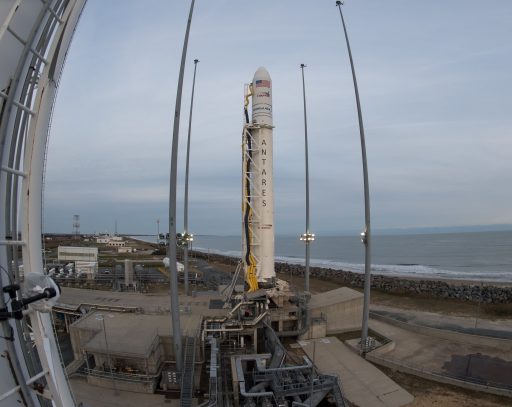
Temperatures were slightly warmer than for Saturday’s attempt but again reached sub-zero Celsius temperatures over night, requiring Antares to be kept warm with heated purge flow under the fairing, into the avionics bay and to the engine section. All power-up steps in the early countdown portion went well and the Red Team departed the pad at around L-4 hours to permit Flight Termination System safe/arm tests and the setup for propellant loading.
With a clean vehicle and 90% odds of favorable weather, teams were able to press into propellant loading at T-1 hour and 35 minutes to fill the rocket’s first stage with 65 metric tons of Rocket Propellant 1 and around 177 tons of Liquid Oxygen oxidizer. While tanking was underway, the launch team configured the rocket’s navigation system, went through a second round of communication/FTS checks and transitioned Cygnus to its launch configuration.
The Launch Team was forced to move the launch to the end of the day’s five-minute window as the Coast Guard had to chase a pair of boats out of the Launch Hazard Area.
A poll at T-10 minutes cleared Antares for liftoff and the Launch Team completed the last manual steps to transition Antares to internal power and arm all ordnances on the vehicle and the ground. Computers assumed control of the count at T-3 minutes to transition the guidance system to flight mode and pressurize the first stage followed by a last gimbal check on the engines in the last 30 seconds to liftoff.
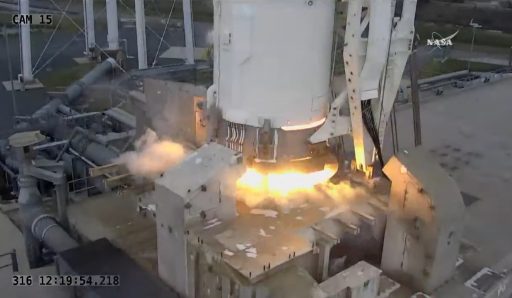
Antares fired up its two RD-181 engines at the moment clocks hit zero at 12:19:51 UTC, soaring to a combined launch thrust of 392 metric ton-force with blastoff occurring 3.6 seconds after the ignition command was issued when both engines were verified to be operational. Rising from its pad half an hour after sunrise, Antares swiveled its engines to move the tail away from the Transporter-Erector Launcher and continuing an initial vertical climb of around 15 seconds.
Antares then entered its pitch and roll maneuver to align itself with a trajectory to the south east to intercept the orbital plane of the Space Station. Burning 1,200 Kilograms of propellant per second, Antares went through the sound barrier one minute into the flight and throttled back to 65% on its engines during the area of Maximum Dynamic Pressure, going through 8 Kilometers in altitude.
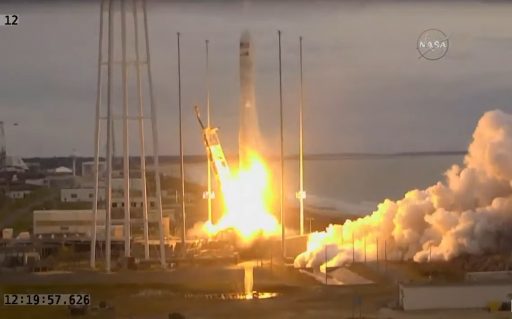
Performance by the first stage was rock solid and the two RD-181 engines shut down at T+3 minutes and 34 seconds after accelerating Antares to a speed of 3.8 Kilometers per second and taking it to an altitude of over 100 Kilometers. Separation of the spent core stage occurred six seconds after shutdown and the Castor 30XL stage immediately activated its cold-gas reaction control system to maintain a stable orientation for a passive coast phase of 43 seconds after staging to gain altitude.
Four minutes and 11 seconds into the mission, the ten-meter long fairing halves split open and separated as the stack passed 155 Kilometers in altitude where aerodynamic forces were no-longer a concern. The second stage dropped its interstage cover to shed more unneeded weight and fired up the Castor 30XL solid rocket motor at T+4 minutes and 23 seconds to boost Cygnus into Low Earth Orbit.
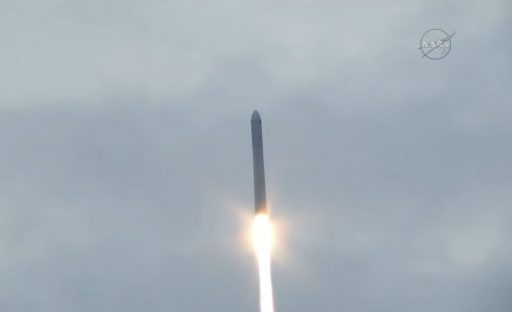
Six meters in length and 2.34 meters in diameter, the Castor 30XL burned 24 metric tons of propellant over the course of a two-minute and 40-second firing. Castor 30XL delivered an average thrust of over 30 metric-ton force, peaking at 40,400kgf in the early portion of its burn before entering an extended tail-off designed to keep G-loads within limits toward the end of the burn when the vehicle is the lightest.
Telemetry displays showed Antares reaching an orbit of 200 by 328 Kilometers, 51.63° at the point of Castor 30XL burnout seven minutes and six seconds into the flight, marking an on-target & slightly-better-than-planned insertion of the vehicle. After burnout, the stage went into a two-minute coast to allow residual thrust to fully tail-off before sending the spacecraft on its way.
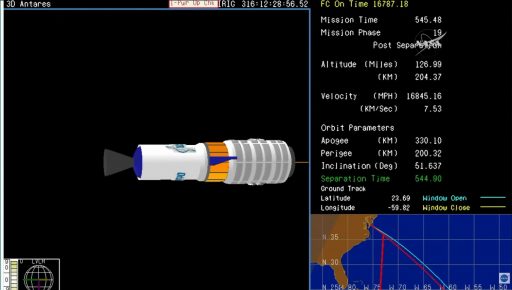
Springs pushed the Cygnus away from the second stage nine minutes after liftoff with the spacecraft’s first tasks being the acquisition of stable three-axis control and the initiation of communications through the Tracking and Data Relay Satellite System to provide health telemetry to Orbital’s Mission Control Center in Dulles, Virginia. Deployment of the two power-generating solar arrays is expected 90 minutes after launch and will take approximately 20 minutes to complete and confirm Cygnus is power-positive and ready for its commute to ISS.
Heading off on a two-day rendezvous, Cygnus will conduct its initial orbit raising maneuvers later on Sunday with more fine-tuning maneuvers on Monday to set up for rendezvous on Tuesday. Approaching from behind and below, Cygnus will enter a climb straight up to ISS to arrive at the capture position within reach of the Station’s robotic arm that will be controlled by ESA Astronaut Paolo Nespoli for a planned capture at 9:50 UTC on Tuesday.

